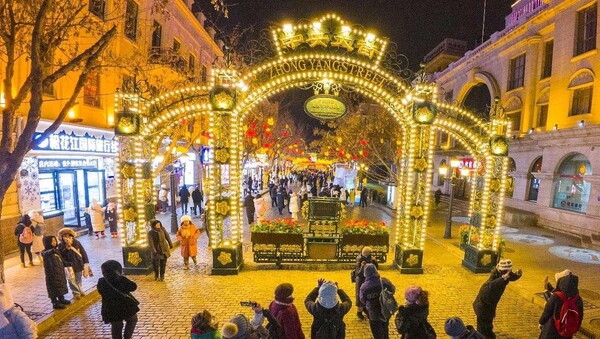By Wang Jingyue
Last winter, Harbin in Northeast China’s Heilongjiang Province just became popular and became a tourist hotspot on the Internet.
According to statistics from the Big Data Research Institute, a subsidiary of Sina Technology, Harbin tourism information began to surge in late December last year. The total amount of online information exceeded 10 million, an increase of four times year-on-year.
Social media pages are flooded with videos showcasing Harbin’s special features. In the picture, Oroqen people are walking on the street while holding reindeer, wearing traditional hats made of Siberian roe deer fur. The plump Arctic fox curls up docilely in the arms of tourists, with eyes narrowed into slits. There are also delicate frozen pear slices and Pear slices. Artificial moon hangs above Hagia Sophia…

Driven by the popularity of social media, offline tourism in Harbin is also booming. According to big data analysis by the Harbin Culture and Tourism Bureau, during the three-day New Year holiday, the city received more than 3 million tourists and generated tourism revenue of 5.9 billion yuan ($821.11 million), which was 4.4 times and 4.4 times that of the same period last year. 7.9 times. The figures are for the same period last year respectively. During the Spring Festival, Harbin received more than 10 million tourists and tourism revenue reached 16.42 billion yuan, both reaching record highs.
Harbin’s popularity reminds people of other Chinese cities that have been popular with the Internet: Chongqing, Changsha in Hunan, Zibo in Shandong, Litang in Sichuan…
Although these cities have different characteristics and styles, they all attract a large number of tourists with their diverse urban landscapes.
Wang Xin, deputy dean of the School of Advertising at Communication University of China, said cities can tap into and amplify unique spaces and cultural activities based on residents and tourists’ existing perceptions of urban culture, thereby forming iconic cultural concepts. These cultural concepts were then widely disseminated through social media, attracting the attention of people who were not present and allowing those present to gain first-hand experience.

For example, people who are not in Harbin can view the city’s attractions online, while visitors to Harbin can share their personal experiences by posting photos on social media. This process has exponentially attracted more tourists to spontaneously participate in the promotion of the “Internet Famous City”.
How can “Internet Famous City” attract more tourists? They have mastered this art.
As the starting point of the ancient Maritime Silk Road, Quanzhou uses its rich intangible cultural heritage resources to launch experiential activities to encourage tourists to not only enjoy local puppet performances, but also try to operate the puppets themselves.
In addition, the city has opened a night market and added evening performances by local theater groups, expanding night travel options for tourists.
Dali Bai Autonomous Prefecture in southwestern China’s Yunnan Province, a famous tourist destination that gained fame on the Internet, is cultivating a coffee-centric urban culture. Nowadays, when tourists come to Dali, they can not only enjoy the beautiful scenery of Cangshan Mountain and Erhai Lake, but also taste different varieties of coffee and feel the charm of the “Coffee City”.
For those cities that have become popular on the Internet through TV series and movies, the relevant governments have adopted creative approaches to integrate the characteristics of the city with the filming locations.
For example, the online drama “Bad Boy” was filmed in Chikan Old Street, Zhanjiang City, Guangdong Province. After the sensation, the local government invited historical and cultural experts to train a volunteer service team, allowing the volunteer service team to share the rich historical and cultural heritage of the old street with tourists.

No matter what drives a city to become an Internet celebrity city, “Internet celebrity cities” are trying to integrate culture and tourism. This allows visitors to take away more than just “buzzwords” and “catchphrases” and leaves them with a deeper and more lasting memory.
How to transform network data traffic into long-term popularity and sustainable development is a question that every “famous Internet city” is thinking about. Experts believe that adhering to a tourist-centered concept is crucial to the prosperity of urban tourism. Providing comprehensive and thoughtful public services is crucial to retaining tourists.
“Service awareness is cultivated over a long period of time.” said Liu Simin, vice president of the tourism branch of the China Future Research Society. Concentrating efforts on improving tourist services in the short term can temporarily alleviate the pressure during the peak tourist season. However, only by creating an overall tourism-friendly environment and continuously improving supporting facilities and services can “Internet Famous City” maintain its long-term popularity. Public Service.
Culture is the soul of a city. “When online fame becomes a thing of the past, in order to retain passenger traffic and maintain lasting appeal, cities must pay attention to local culture and residents, because these are elements that cannot be replicated,” said Huang Zhuowei, associate professor at the University of Chinese Academy of Sciences. School of Tourism Management, Sun Yat-sen University. He added that it’s important to develop non-mainstream attractions or attractions that aren’t driven by online trends.
